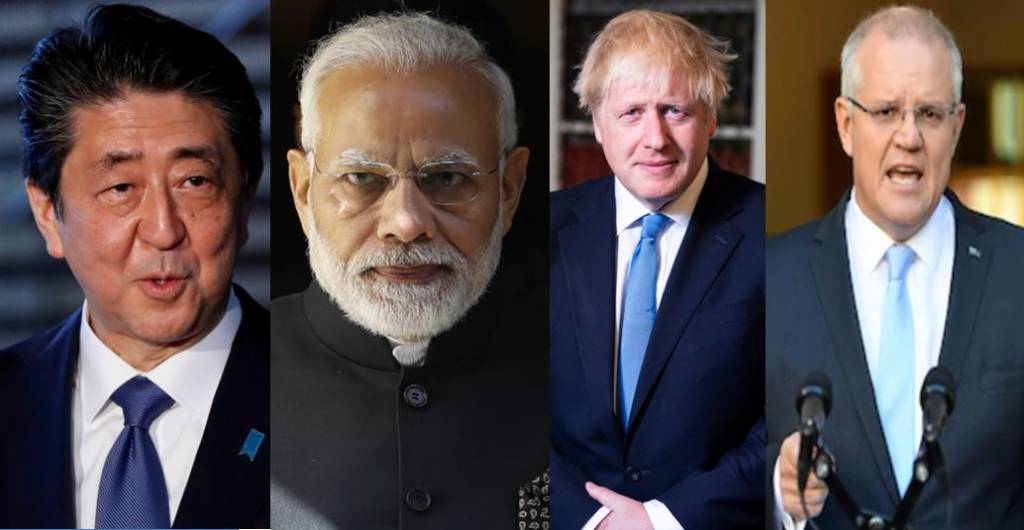There is more trouble brewing for China in the Indo-Pacific and Japan is at the forefront of its woes this time around. Tokyo is looking to expand cooperation in defence intelligence sharing with countries such as India, Australia, France, and the United Kingdom. With this, Japan is looking to broaden the scope of its State secret laws to exchange information with allies beyond the US too.
By amending the state secrets law, Tokyo will pave way for sharing critical information on Chinese troop movements with the UK, France and India apart from the US. This comes as the Dragon has been flexing its muscles in the East China Sea. Chinese Coast Guard vessels have been hovering around Japan’s Senkaku Islands, which Beijing claims as Diaoyu, for the past 80 days, and Japan has been struggling to keep a tab on all of China’s provocative movements.
Japan has signed agreements with all its democratic allies in the Indo-Pacific Region, viz. Australia, India, France, and the UK. These agreements obligate both sides to keep classified information secret. This should encourage countries to share data which remains confidential.
Japan is growing increasingly aware of the threat that China poses to it and its allies in the Indo-Pacific, and is thus trying to watch over Chinese movement. This is part of Japan’s larger goal of collective self-defence and cooperation by supplying fuel, ammunition, and other logistics to the military forces of other countries in real-time situations that pose a threat to Japan.
To implement these missions in battle situations, Japan would need specific data on the size, capacity, and operating areas of these forces. This is highly secretive information and Tokyo wants to be ready with an apparatus to share information and intelligence with its allies and friendly militaries.
This is going to bolster further co-operation in the Indo-Pacific to cut Chinese influence to size. This will also help materialise cooperation within the Quad- an informal strategic grouping to contain Chinese influence in the Indo-Pacific. Japan cooperating with other partners completes the strategic axis against China.
India and Australia signed a Mutual Logistics Support Agreement last month. The Navies of the two countries can access each other’s ports for logistics such as food, water, and petroleum. India and the US already have a similar pact called the Logistics Exchange Memorandum of Agreement (LEMOA).
Similarly, Australia and the US also cooperate in the Pacific as a part of the ANZUS Pact, formally called the Pacific Security Treaty amongst Australia, New Zealand, and the US. The only missing link in this chain was Japan. But if Japan too enters intelligence-sharing agreements with India and Australia, the entire Quad would get inter-locked into a strategic axis against Beijing.
This also opens up new avenues and expands the scope for joint training exercises and collaborations for equipment development with an eye on China. Japan has already participated in the India-US-Japan Malabar naval exercise on an annual basis since 2015.
Currently, the Japanese Maritime Self Defence Forces conducted a joint training exercise with the Indian Navy in the Indian Ocean. This was critical in the larger backdrop of soaring military tensions between the Indian Army and the Chinese People’s Liberation Army (PLA) at the Line of Actual Control (LAC) in Eastern Ladakh.
Democratic countries in the Indo-Pacific have found a common threat in China, and they are trying to create a string of pearls of their own to encircle the expansionist bully. This is different from China’s revisionist idea of creating a string of pearls around India through ports and bases in countries like Pakistan and Sri Lanka.
China uses debt-traps and wrongful influence in the domestic affairs of other countries to gain influence in areas outside its domain. But countries like Japan, India, Australia, and even the ASEAN countries like Vietnam and the Philippines want to collaborate among themselves willingly. They are only trying to defend themselves as China illegally claims sovereignty inside their territorial waters.
Japan’s greater involvement allows the establishment of a shared geo-intelligence network. At least, we are moving in that direction. China is being watched now. If the Chinese Navy moves in the Northwest of the Strait of Malacca, New Delhi gets to track it through the Andaman and Nicobar Islands. If the Chinese assets move to the Southeast of the Strait, Australia gets to watch over it through the Cocos Islands and share its movement with other allies in the region.
Finally, Japan can look over China in the East China Sea and the South China Sea, where Chinese actions are threatening to block the Sea Lines of Communication (SLOCs) in the international waters. This is crucial for Australia, the US, and India because they desire freedom of navigation and lack of hindrance in their trade routes.
The Chinese People’s Liberation Army Nacy (PLAN) is a Green-water Navy, unable to exert influence beyond its local range. It wants to become a Blue-water Navy but Japan and its allies have decided to play spoilsport and encircle it on all littoral fronts from where it wants to expand influence.
